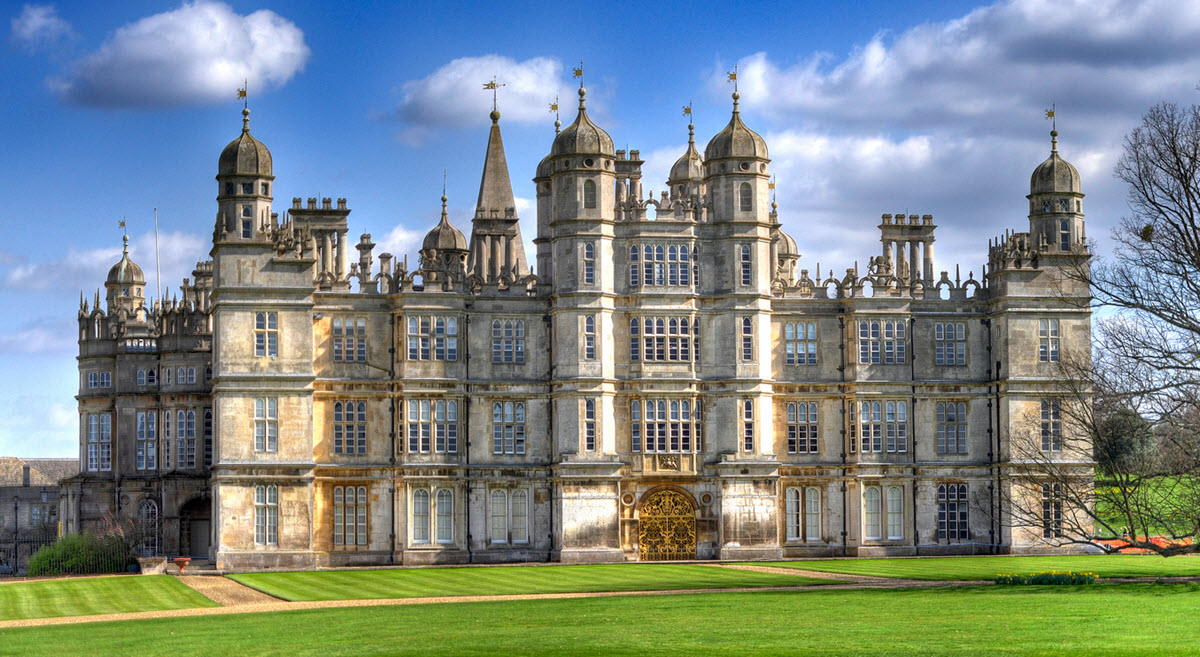Contents
Burghley House is a grand English country house dating back to the 16th century. Famous for its Elizabethan exterior, this prodigy house was built in 1555-1587 for Sir William Cecil, who was Lord High Treasurer to Queen Elizabeth of England for most of her reign. Eventually, he became the 1st Baron Burghley.
Ever since it´s creation, Burghley House – which was largely designed by Sir William Cecil himself – has been inhabited by members of the Cecil family, the Earls, and since 1801, the Marquesses of Exeter. The Burghley House Preservation Trust, a charitable trust established by the Cecil family, now owns and run Burghley House (since 1961).
The Burghley House park was designed by Lancelot Capability Brown in the 18th century. It is famous for hosting the Burghley Horse Trials, a three-day event held in September each year, as well as the Burghley Run for Stamford School.
You can learn more about Burghley House in BBC Two´s 2006 series “Castle in the Country”.

Where is Burghley House?
Burghley House is located in Lincolnshire, not far from the town Stamford and roughly 10 miles northwest of the town Peterborough. The distance to Stamford is less than a mile.
Coordinates: 52.642393°N 0.452585°W
The estate is on the boundary of the civil parishes of Barnack and St Martin´s Without in the Peterborough unitary authority of Cambridgeshire. Earlier, Burghley House was a part of the ancient Soke of Peterborough, and was thus associated with Northamptonshire.
The Lincolnshire county boundary runs through the park, between the house itself and the town Stamford.
Is it open to the public?
Yes, parts of the Burghley House and the parkland is open to the public. The house displays a a circuit of richly furnished state apartments.
About the house
Construction started: 1555
Architectural style: Elizabethan
Structural system: Ashlar limestone
The house is a Grade I listed building, with a separately Grade I listed north courtyard and gate.
When the house was built in 1555-1587, its architecture was strongly inspired by the Richmond Palace´s privy lodgings. The building cost was c. £21,000.
The exterior of the house is well preserved and retains most of its Elizabethan appearance, while the interior has been altered throughout the centuries – although most of the interior has not undergone any major remodelling since the 18th century.
Among other things, the interior features a suite of rooms remodelled in the baroque style, adorned with carvings by Grinling Gibbons. There are also the famous “Hell Staircase” and “Heaven Rooms” – both with massive ceiling paintings created by Antonio Verrio in 1697-1699. Roughly a century later, the walls of the Hell Staircase were painted by Thomas Stothard.
How many rooms are there?
The main part of the house contains 35 major rooms on the ground floor and first floor. In addition to this, there are more than 80 lesser rooms, as well as plenty of halls, corridors, service areas and bathrooms.
Parkland and gardens
The parkland and gardens are listed Grade II* on the Register of Historic Parks and Gardens.
In the 18th century, the family contracted the renowned landscape designer Capability Brown and paid him a total of £23,000 to create a fashionable park for Burghley House. Since then, the Burghley House parkland features avenues laid out in accordance with 1755-1779 designs by Brown. When the avenues were created, pre-existing plantings – some of them dating back to the 16th century – were duly respected. In 2012-2016, 30,000 new trees were planted to conserve
Brown´s original designs.
The parkland was to become very important for the estate, and the house was even altered to allow better views of the new parkland. The house had originally been built in the shape of an E to honour Queen Elizabeth, but under the guidance of Capability Brown, the north-west wing was demolished and the south front was raised.
The lake
Capability Brown discovered a seam of waterproof clay in the grounds here, and used this knowledge to turn a nine-acre pond into a 26-acre lake in 1775-1780.
The stone lions
The first set of ornamental lions in the park was made from coade stone. In 1844, these weathered lions were replaced by lions made by the local masion Herbert Gilbert.
The Garden of Surprises
In 2007, the Garden of Surprises was created using shell grottos, water traps and similar. It includes, among other things, a mirror maze.
Film & TV
Since Burghley House retains a well preserved Elizabethan exterior, it has been selected as the location for several historical and period movies and TV-shows. The interior also contains a variety of suitable rooms for stories set in the past.
Examples of films and television programs where you can see Burghley House:
- Middlemarch (1994 TV-series)
- The Da Vinci Code (film)
- Pride & Prejudice (2005 film)
- Elizabeth: The Golden Age (2007 biographical drama film)
- Housefull 2: The Dirty Dozen (2012 film)
